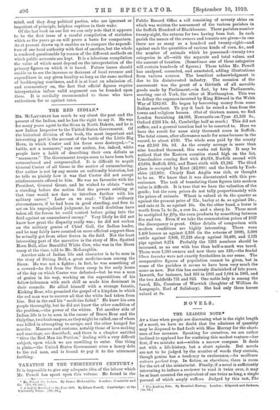TAXATION IN THE THIRTEENTH CENTURY.t IT is impossible to give
any adequate idea of the labour which Mr. Powell has spent upon this volume. He found in the
• My Friend lie Indian. By James McLaughlin. London: Constable and Co. ilea. 6d. net.] t A Suffolk Hundred in the Tear 1251 By Edgar Powell. Cambridge: at the University Press. [10s. 6.1.1 Public Record Office a roll consisting of seventy skins on which was written the assessment of the various parishes in the Suffolk Hundred of Blackbourne. These parishes number twenty-eight, the returns for two having been lost. In each parish the names of the owners and tenants are given—in one there are as many as a hundred and twenty-eight—and against each the quantities of various kinds of corn, &c., and the number of animals which he possessed—twenty-two categories in all—with the separate and total values, and the amount of taxation. (Sometimes one of these categories will contain hundreds of figures.) These tables Mr. Powell has analysed, corrected, and annotated, adding illustrations from various sources. The heartiest acknowledgment is due to his disinterested industry. The occasion of the assessment was the grant of a thirtieth of all movable goods made by Parliament,—in fact, by two Parliaments, meeting one at York, the other at Northampton. This was to defray the expenses incurred by King Edward in the Welsh War of 1282-83. He began by borrowing money from some Italian merchant. To pay it back he raised a loan from the towns and religious houses. (Out of thirteen names, we find London furnishing £4,000, Newcastle-on-Tyne £1,163 9s., Oxford £26613s. 4d., Cambridge half as much.) This did not suffice, and a general taxation had to be resorted to. Here we have the result for some sixty thousand acres in Suffolk. The total comes, after allowances made for some lacunae in the record, to about £130. The whole suns paid by the county was £2,103 18s. 9d. As the county acreage is more than nine hundred thousand, this works out fairly. It may be noticed that the Eastern counties stand high on the list, Lincolnshire coming first with £4,018, Norfolk second with £3,684, Suffolk fifth, and Essex sixth with £1,242. The third place is occupied by Kent (22,880) and the fourth by York- shire (22,860). Clearly East Anglia was rich, or thought to be so. We know that it was discontented with this pre- eminence. The task of translating these figures into modern value is difficult. It is true that we have the valuation of the goods ; but the corn prices do not tally proportionately with the prices of animals. Wheat is valued at 6s. the quarter as against the present price of 32s., barley at 4s. as against 24s., and oats at 2s. as against 16s. On the other hand, a horse is worth from 7s. to 2s., a cow 5s., and a sheep is. These must be mutiplied by fifty, the corn products by something between five and ten. Even if we take the commutation prices of 1837 the discrepancy is great. Other details of comparison with modern conditions are highly interesting. There were 1,408 horses as against 2,368 (in the returns of 1908), 5,098 cattle against 3,868, 17,128 sheep against 34,400, and 2,121 pigs against 8,274. Probably the 1283 numbers should be increased, as no one with less than half-a-mark was taxed. There were 1,380 owners and now there are 519,—the feudal libere tenentes were not exactly freeholders in our sense. The comparative figures of population cannot be given, but in some of the parishes it seems to have been very much the same as now. But this has seriously diminished of late years. Ixworth, for instance, bad 856 in 1901 and 1,004 in 1881, and the two Ashfields 731 and 843. One noble lady is among the taxed, Ela, Countess of Warwick (daughter of William de Longespee, Earl of Salisbury). She had only three horses valued at 9s.






































 Previous page
Previous page